Social Media Communication Management: A Comprehensive Report
VerifiedAdded on 2022/12/28
|8
|1797
|44
Report
AI Summary
This report delves into the complexities of social media communication management, examining the challenges posed by social media tools compared to traditional communication channels. It explores the impact of employee comments and behavior on an organization's identity and reputation, emphasizing the need for a robust social media policy. The report outlines the essential components of such a policy, covering aspects like confidential information, prohibited content, and designated company representatives. Furthermore, it presents a communication strategy, using a communication plan template, for the Director of Social Media to effectively communicate the policy to staff. The strategy includes considerations for timing, audience, key messages, desired outcomes, and frequency of posts, with the goal of creating a positive brand image and fostering trust among stakeholders. The report concludes by highlighting the importance of a well-defined social media policy and effective communication to enhance a company's business image, using the case of Sunshine 100 as an example, while referencing multiple research papers to support the findings.
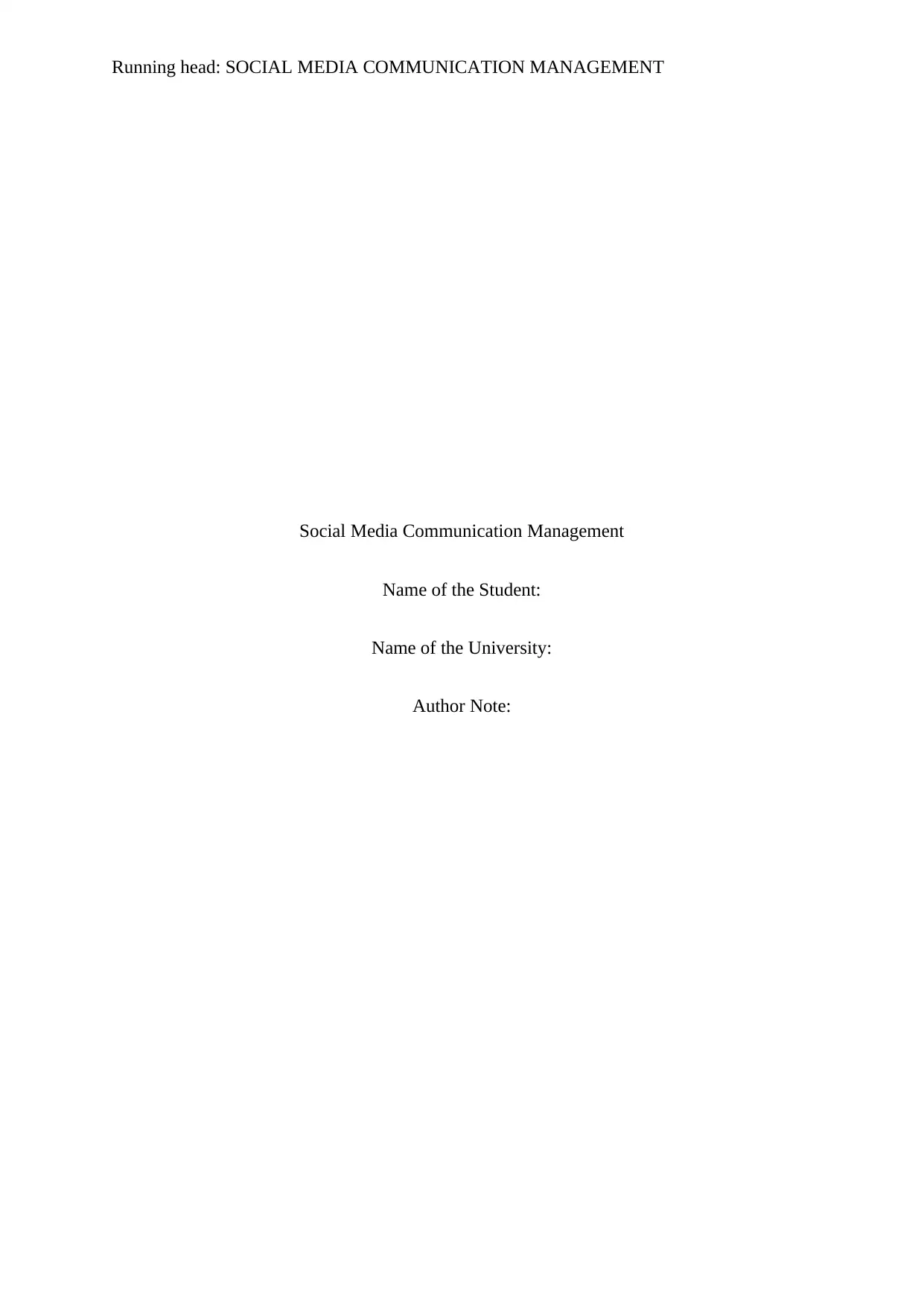
Running head: SOCIAL MEDIA COMMUNICATION MANAGEMENT
Social Media Communication Management
Name of the Student:
Name of the University:
Author Note:
Social Media Communication Management
Name of the Student:
Name of the University:
Author Note:
Paraphrase This Document
Need a fresh take? Get an instant paraphrase of this document with our AI Paraphraser
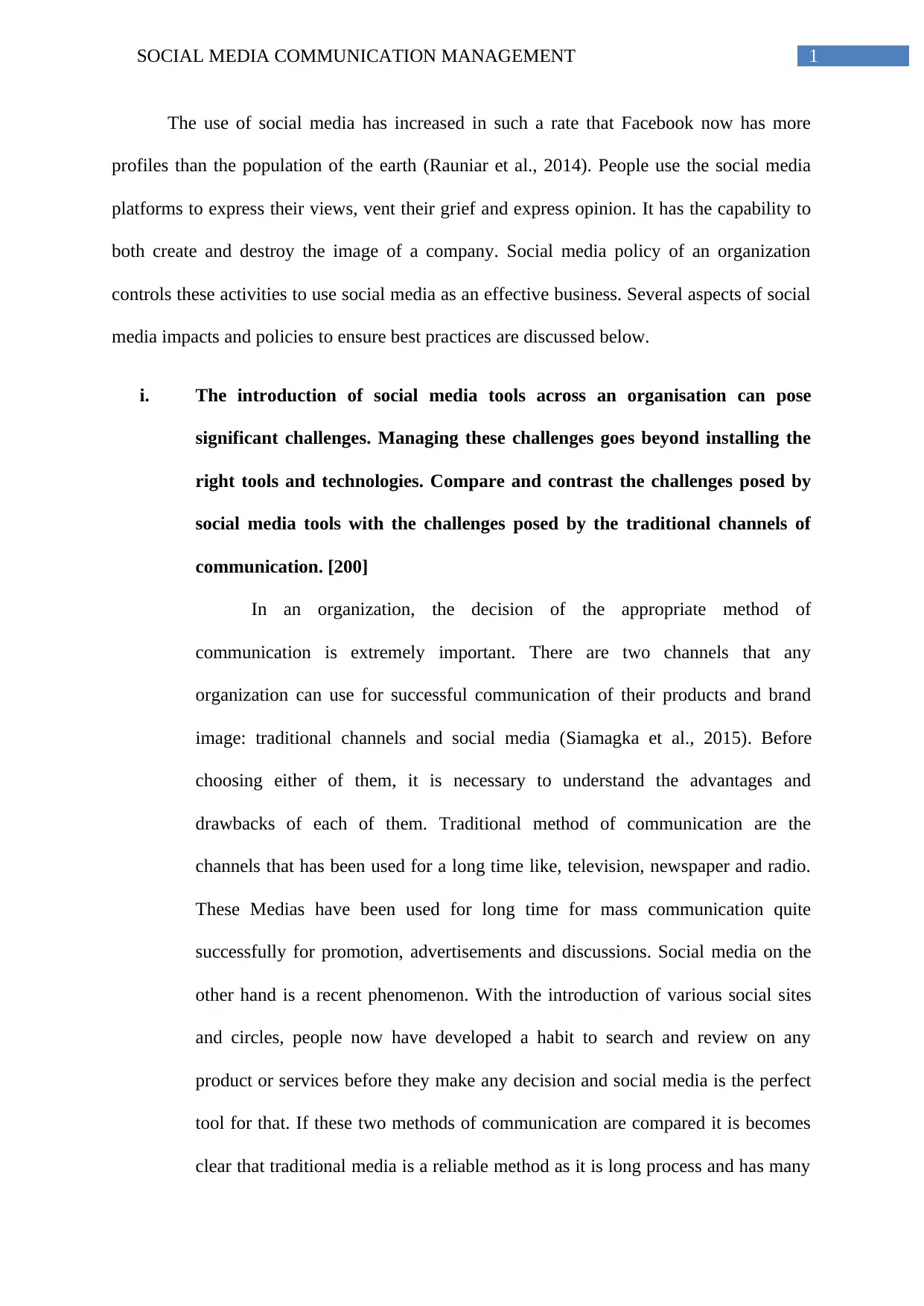
1SOCIAL MEDIA COMMUNICATION MANAGEMENT
The use of social media has increased in such a rate that Facebook now has more
profiles than the population of the earth (Rauniar et al., 2014). People use the social media
platforms to express their views, vent their grief and express opinion. It has the capability to
both create and destroy the image of a company. Social media policy of an organization
controls these activities to use social media as an effective business. Several aspects of social
media impacts and policies to ensure best practices are discussed below.
i. The introduction of social media tools across an organisation can pose
significant challenges. Managing these challenges goes beyond installing the
right tools and technologies. Compare and contrast the challenges posed by
social media tools with the challenges posed by the traditional channels of
communication. [200]
In an organization, the decision of the appropriate method of
communication is extremely important. There are two channels that any
organization can use for successful communication of their products and brand
image: traditional channels and social media (Siamagka et al., 2015). Before
choosing either of them, it is necessary to understand the advantages and
drawbacks of each of them. Traditional method of communication are the
channels that has been used for a long time like, television, newspaper and radio.
These Medias have been used for long time for mass communication quite
successfully for promotion, advertisements and discussions. Social media on the
other hand is a recent phenomenon. With the introduction of various social sites
and circles, people now have developed a habit to search and review on any
product or services before they make any decision and social media is the perfect
tool for that. If these two methods of communication are compared it is becomes
clear that traditional media is a reliable method as it is long process and has many
The use of social media has increased in such a rate that Facebook now has more
profiles than the population of the earth (Rauniar et al., 2014). People use the social media
platforms to express their views, vent their grief and express opinion. It has the capability to
both create and destroy the image of a company. Social media policy of an organization
controls these activities to use social media as an effective business. Several aspects of social
media impacts and policies to ensure best practices are discussed below.
i. The introduction of social media tools across an organisation can pose
significant challenges. Managing these challenges goes beyond installing the
right tools and technologies. Compare and contrast the challenges posed by
social media tools with the challenges posed by the traditional channels of
communication. [200]
In an organization, the decision of the appropriate method of
communication is extremely important. There are two channels that any
organization can use for successful communication of their products and brand
image: traditional channels and social media (Siamagka et al., 2015). Before
choosing either of them, it is necessary to understand the advantages and
drawbacks of each of them. Traditional method of communication are the
channels that has been used for a long time like, television, newspaper and radio.
These Medias have been used for long time for mass communication quite
successfully for promotion, advertisements and discussions. Social media on the
other hand is a recent phenomenon. With the introduction of various social sites
and circles, people now have developed a habit to search and review on any
product or services before they make any decision and social media is the perfect
tool for that. If these two methods of communication are compared it is becomes
clear that traditional media is a reliable method as it is long process and has many
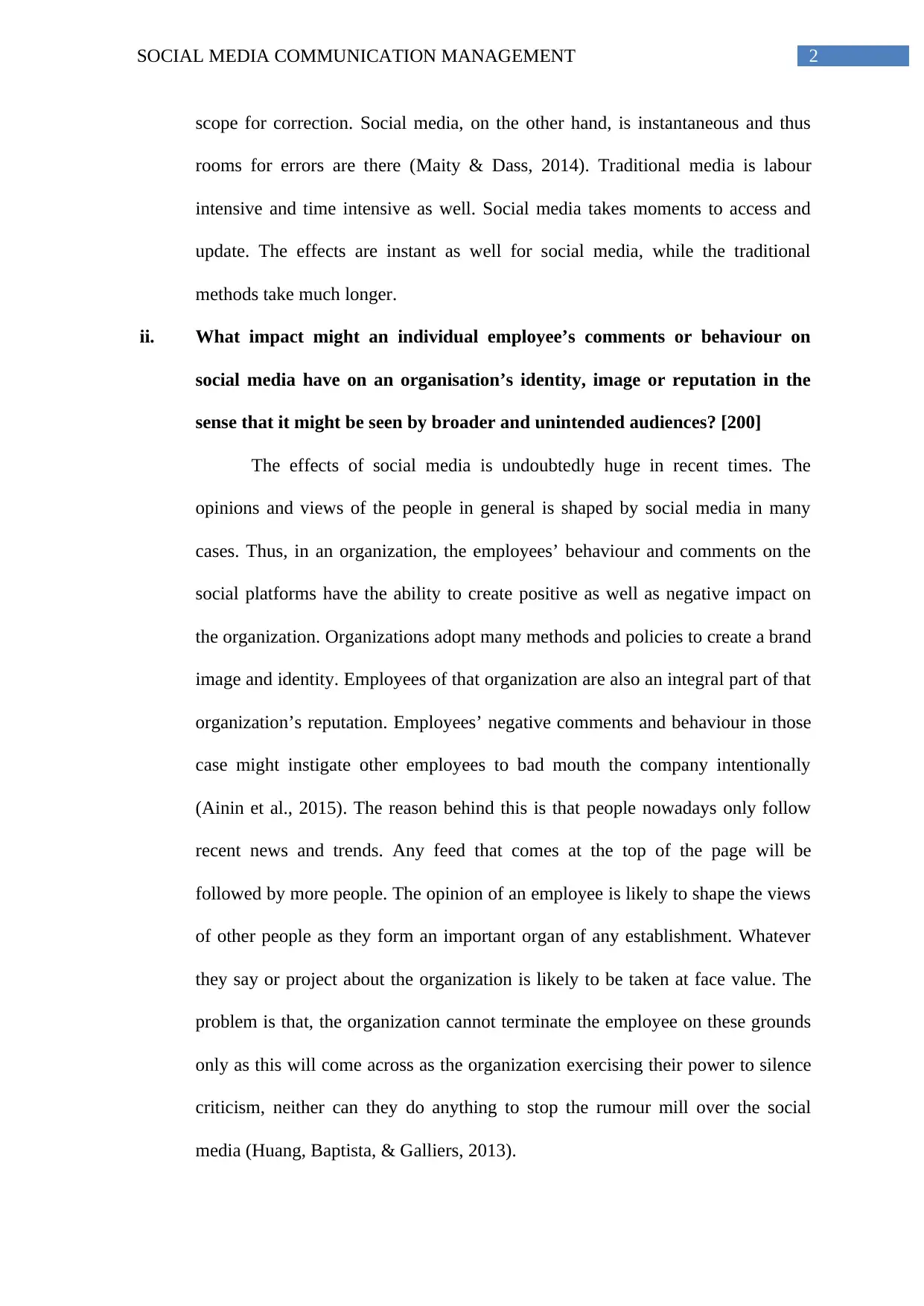
2SOCIAL MEDIA COMMUNICATION MANAGEMENT
scope for correction. Social media, on the other hand, is instantaneous and thus
rooms for errors are there (Maity & Dass, 2014). Traditional media is labour
intensive and time intensive as well. Social media takes moments to access and
update. The effects are instant as well for social media, while the traditional
methods take much longer.
ii. What impact might an individual employee’s comments or behaviour on
social media have on an organisation’s identity, image or reputation in the
sense that it might be seen by broader and unintended audiences? [200]
The effects of social media is undoubtedly huge in recent times. The
opinions and views of the people in general is shaped by social media in many
cases. Thus, in an organization, the employees’ behaviour and comments on the
social platforms have the ability to create positive as well as negative impact on
the organization. Organizations adopt many methods and policies to create a brand
image and identity. Employees of that organization are also an integral part of that
organization’s reputation. Employees’ negative comments and behaviour in those
case might instigate other employees to bad mouth the company intentionally
(Ainin et al., 2015). The reason behind this is that people nowadays only follow
recent news and trends. Any feed that comes at the top of the page will be
followed by more people. The opinion of an employee is likely to shape the views
of other people as they form an important organ of any establishment. Whatever
they say or project about the organization is likely to be taken at face value. The
problem is that, the organization cannot terminate the employee on these grounds
only as this will come across as the organization exercising their power to silence
criticism, neither can they do anything to stop the rumour mill over the social
media (Huang, Baptista, & Galliers, 2013).
scope for correction. Social media, on the other hand, is instantaneous and thus
rooms for errors are there (Maity & Dass, 2014). Traditional media is labour
intensive and time intensive as well. Social media takes moments to access and
update. The effects are instant as well for social media, while the traditional
methods take much longer.
ii. What impact might an individual employee’s comments or behaviour on
social media have on an organisation’s identity, image or reputation in the
sense that it might be seen by broader and unintended audiences? [200]
The effects of social media is undoubtedly huge in recent times. The
opinions and views of the people in general is shaped by social media in many
cases. Thus, in an organization, the employees’ behaviour and comments on the
social platforms have the ability to create positive as well as negative impact on
the organization. Organizations adopt many methods and policies to create a brand
image and identity. Employees of that organization are also an integral part of that
organization’s reputation. Employees’ negative comments and behaviour in those
case might instigate other employees to bad mouth the company intentionally
(Ainin et al., 2015). The reason behind this is that people nowadays only follow
recent news and trends. Any feed that comes at the top of the page will be
followed by more people. The opinion of an employee is likely to shape the views
of other people as they form an important organ of any establishment. Whatever
they say or project about the organization is likely to be taken at face value. The
problem is that, the organization cannot terminate the employee on these grounds
only as this will come across as the organization exercising their power to silence
criticism, neither can they do anything to stop the rumour mill over the social
media (Huang, Baptista, & Galliers, 2013).
⊘ This is a preview!⊘
Do you want full access?
Subscribe today to unlock all pages.

Trusted by 1+ million students worldwide
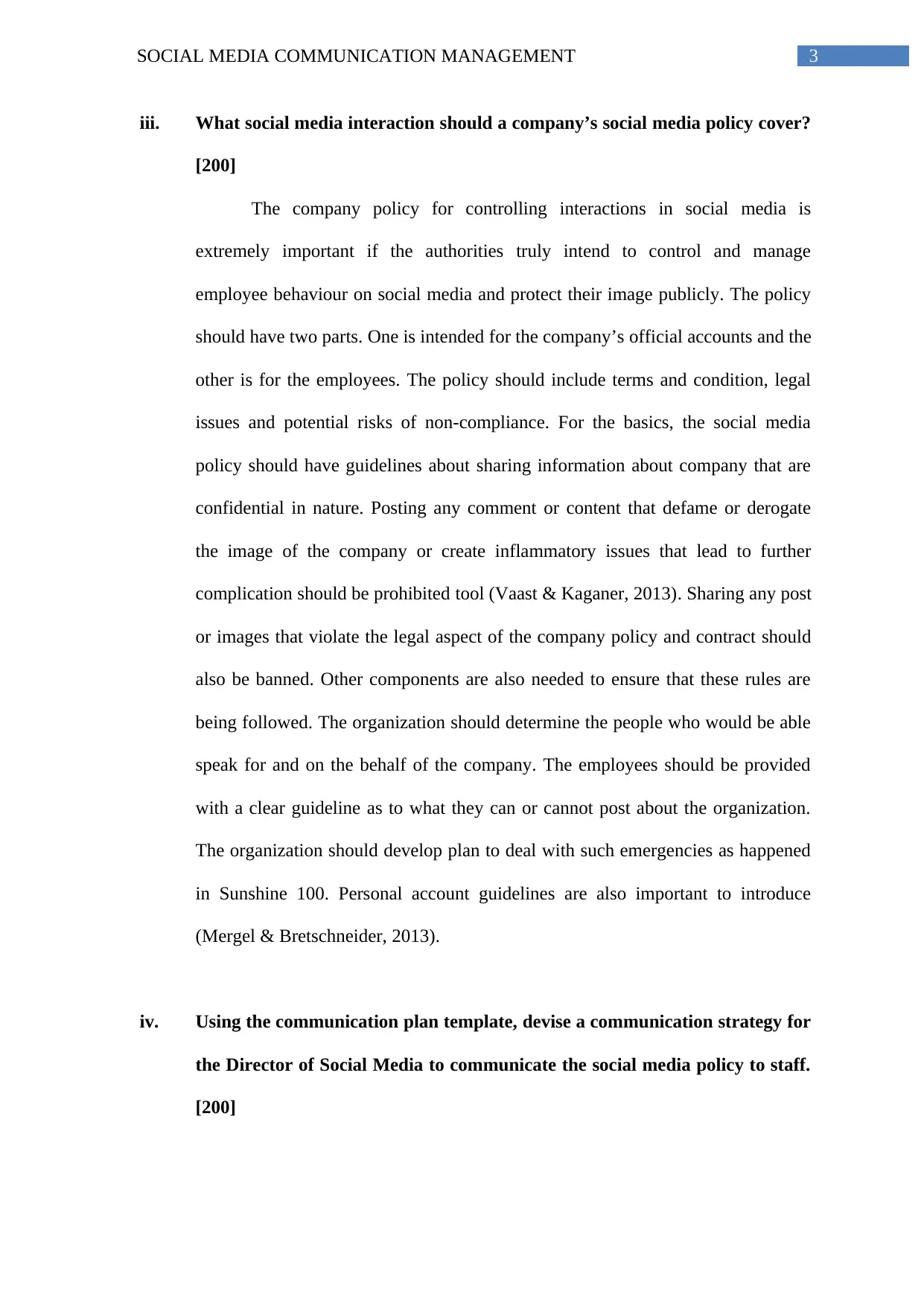
3SOCIAL MEDIA COMMUNICATION MANAGEMENT
iii. What social media interaction should a company’s social media policy cover?
[200]
The company policy for controlling interactions in social media is
extremely important if the authorities truly intend to control and manage
employee behaviour on social media and protect their image publicly. The policy
should have two parts. One is intended for the company’s official accounts and the
other is for the employees. The policy should include terms and condition, legal
issues and potential risks of non-compliance. For the basics, the social media
policy should have guidelines about sharing information about company that are
confidential in nature. Posting any comment or content that defame or derogate
the image of the company or create inflammatory issues that lead to further
complication should be prohibited tool (Vaast & Kaganer, 2013). Sharing any post
or images that violate the legal aspect of the company policy and contract should
also be banned. Other components are also needed to ensure that these rules are
being followed. The organization should determine the people who would be able
speak for and on the behalf of the company. The employees should be provided
with a clear guideline as to what they can or cannot post about the organization.
The organization should develop plan to deal with such emergencies as happened
in Sunshine 100. Personal account guidelines are also important to introduce
(Mergel & Bretschneider, 2013).
iv. Using the communication plan template, devise a communication strategy for
the Director of Social Media to communicate the social media policy to staff.
[200]
iii. What social media interaction should a company’s social media policy cover?
[200]
The company policy for controlling interactions in social media is
extremely important if the authorities truly intend to control and manage
employee behaviour on social media and protect their image publicly. The policy
should have two parts. One is intended for the company’s official accounts and the
other is for the employees. The policy should include terms and condition, legal
issues and potential risks of non-compliance. For the basics, the social media
policy should have guidelines about sharing information about company that are
confidential in nature. Posting any comment or content that defame or derogate
the image of the company or create inflammatory issues that lead to further
complication should be prohibited tool (Vaast & Kaganer, 2013). Sharing any post
or images that violate the legal aspect of the company policy and contract should
also be banned. Other components are also needed to ensure that these rules are
being followed. The organization should determine the people who would be able
speak for and on the behalf of the company. The employees should be provided
with a clear guideline as to what they can or cannot post about the organization.
The organization should develop plan to deal with such emergencies as happened
in Sunshine 100. Personal account guidelines are also important to introduce
(Mergel & Bretschneider, 2013).
iv. Using the communication plan template, devise a communication strategy for
the Director of Social Media to communicate the social media policy to staff.
[200]
Paraphrase This Document
Need a fresh take? Get an instant paraphrase of this document with our AI Paraphraser
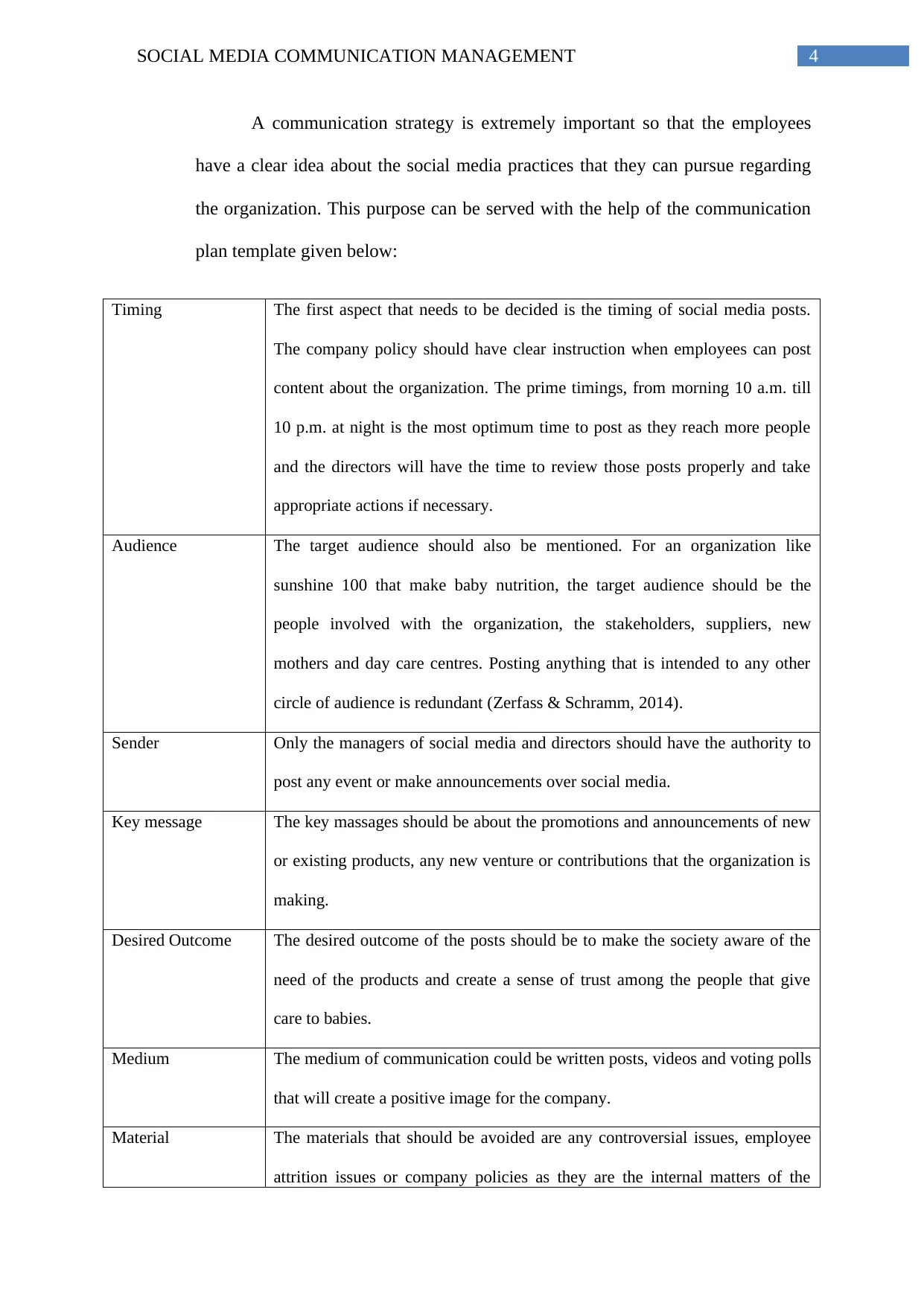
4SOCIAL MEDIA COMMUNICATION MANAGEMENT
A communication strategy is extremely important so that the employees
have a clear idea about the social media practices that they can pursue regarding
the organization. This purpose can be served with the help of the communication
plan template given below:
Timing The first aspect that needs to be decided is the timing of social media posts.
The company policy should have clear instruction when employees can post
content about the organization. The prime timings, from morning 10 a.m. till
10 p.m. at night is the most optimum time to post as they reach more people
and the directors will have the time to review those posts properly and take
appropriate actions if necessary.
Audience The target audience should also be mentioned. For an organization like
sunshine 100 that make baby nutrition, the target audience should be the
people involved with the organization, the stakeholders, suppliers, new
mothers and day care centres. Posting anything that is intended to any other
circle of audience is redundant (Zerfass & Schramm, 2014).
Sender Only the managers of social media and directors should have the authority to
post any event or make announcements over social media.
Key message The key massages should be about the promotions and announcements of new
or existing products, any new venture or contributions that the organization is
making.
Desired Outcome The desired outcome of the posts should be to make the society aware of the
need of the products and create a sense of trust among the people that give
care to babies.
Medium The medium of communication could be written posts, videos and voting polls
that will create a positive image for the company.
Material The materials that should be avoided are any controversial issues, employee
attrition issues or company policies as they are the internal matters of the
A communication strategy is extremely important so that the employees
have a clear idea about the social media practices that they can pursue regarding
the organization. This purpose can be served with the help of the communication
plan template given below:
Timing The first aspect that needs to be decided is the timing of social media posts.
The company policy should have clear instruction when employees can post
content about the organization. The prime timings, from morning 10 a.m. till
10 p.m. at night is the most optimum time to post as they reach more people
and the directors will have the time to review those posts properly and take
appropriate actions if necessary.
Audience The target audience should also be mentioned. For an organization like
sunshine 100 that make baby nutrition, the target audience should be the
people involved with the organization, the stakeholders, suppliers, new
mothers and day care centres. Posting anything that is intended to any other
circle of audience is redundant (Zerfass & Schramm, 2014).
Sender Only the managers of social media and directors should have the authority to
post any event or make announcements over social media.
Key message The key massages should be about the promotions and announcements of new
or existing products, any new venture or contributions that the organization is
making.
Desired Outcome The desired outcome of the posts should be to make the society aware of the
need of the products and create a sense of trust among the people that give
care to babies.
Medium The medium of communication could be written posts, videos and voting polls
that will create a positive image for the company.
Material The materials that should be avoided are any controversial issues, employee
attrition issues or company policies as they are the internal matters of the
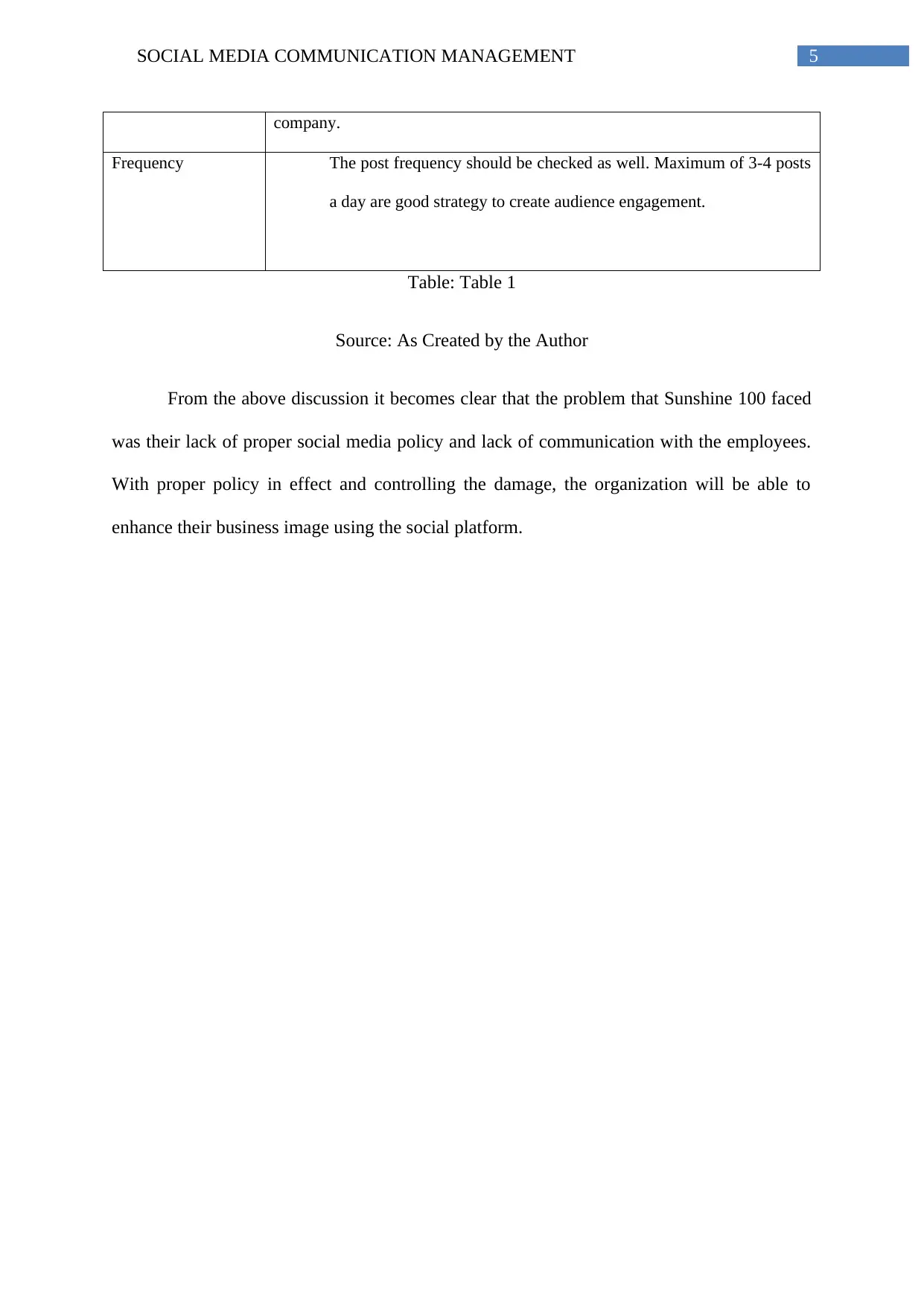
5SOCIAL MEDIA COMMUNICATION MANAGEMENT
company.
Frequency The post frequency should be checked as well. Maximum of 3-4 posts
a day are good strategy to create audience engagement.
Table: Table 1
Source: As Created by the Author
From the above discussion it becomes clear that the problem that Sunshine 100 faced
was their lack of proper social media policy and lack of communication with the employees.
With proper policy in effect and controlling the damage, the organization will be able to
enhance their business image using the social platform.
company.
Frequency The post frequency should be checked as well. Maximum of 3-4 posts
a day are good strategy to create audience engagement.
Table: Table 1
Source: As Created by the Author
From the above discussion it becomes clear that the problem that Sunshine 100 faced
was their lack of proper social media policy and lack of communication with the employees.
With proper policy in effect and controlling the damage, the organization will be able to
enhance their business image using the social platform.
⊘ This is a preview!⊘
Do you want full access?
Subscribe today to unlock all pages.

Trusted by 1+ million students worldwide
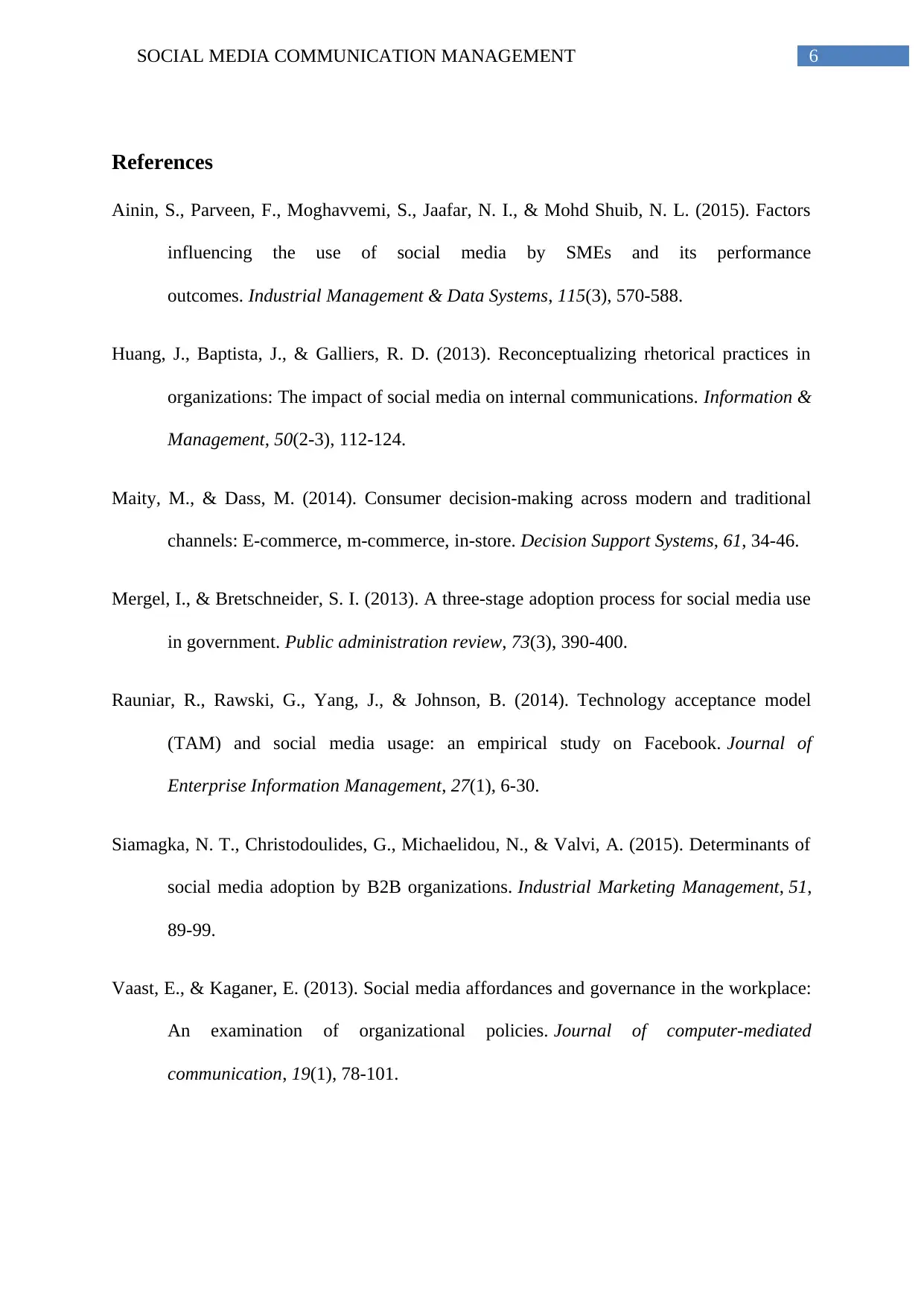
6SOCIAL MEDIA COMMUNICATION MANAGEMENT
References
Ainin, S., Parveen, F., Moghavvemi, S., Jaafar, N. I., & Mohd Shuib, N. L. (2015). Factors
influencing the use of social media by SMEs and its performance
outcomes. Industrial Management & Data Systems, 115(3), 570-588.
Huang, J., Baptista, J., & Galliers, R. D. (2013). Reconceptualizing rhetorical practices in
organizations: The impact of social media on internal communications. Information &
Management, 50(2-3), 112-124.
Maity, M., & Dass, M. (2014). Consumer decision-making across modern and traditional
channels: E-commerce, m-commerce, in-store. Decision Support Systems, 61, 34-46.
Mergel, I., & Bretschneider, S. I. (2013). A three‐stage adoption process for social media use
in government. Public administration review, 73(3), 390-400.
Rauniar, R., Rawski, G., Yang, J., & Johnson, B. (2014). Technology acceptance model
(TAM) and social media usage: an empirical study on Facebook. Journal of
Enterprise Information Management, 27(1), 6-30.
Siamagka, N. T., Christodoulides, G., Michaelidou, N., & Valvi, A. (2015). Determinants of
social media adoption by B2B organizations. Industrial Marketing Management, 51,
89-99.
Vaast, E., & Kaganer, E. (2013). Social media affordances and governance in the workplace:
An examination of organizational policies. Journal of computer-mediated
communication, 19(1), 78-101.
References
Ainin, S., Parveen, F., Moghavvemi, S., Jaafar, N. I., & Mohd Shuib, N. L. (2015). Factors
influencing the use of social media by SMEs and its performance
outcomes. Industrial Management & Data Systems, 115(3), 570-588.
Huang, J., Baptista, J., & Galliers, R. D. (2013). Reconceptualizing rhetorical practices in
organizations: The impact of social media on internal communications. Information &
Management, 50(2-3), 112-124.
Maity, M., & Dass, M. (2014). Consumer decision-making across modern and traditional
channels: E-commerce, m-commerce, in-store. Decision Support Systems, 61, 34-46.
Mergel, I., & Bretschneider, S. I. (2013). A three‐stage adoption process for social media use
in government. Public administration review, 73(3), 390-400.
Rauniar, R., Rawski, G., Yang, J., & Johnson, B. (2014). Technology acceptance model
(TAM) and social media usage: an empirical study on Facebook. Journal of
Enterprise Information Management, 27(1), 6-30.
Siamagka, N. T., Christodoulides, G., Michaelidou, N., & Valvi, A. (2015). Determinants of
social media adoption by B2B organizations. Industrial Marketing Management, 51,
89-99.
Vaast, E., & Kaganer, E. (2013). Social media affordances and governance in the workplace:
An examination of organizational policies. Journal of computer-mediated
communication, 19(1), 78-101.
Paraphrase This Document
Need a fresh take? Get an instant paraphrase of this document with our AI Paraphraser
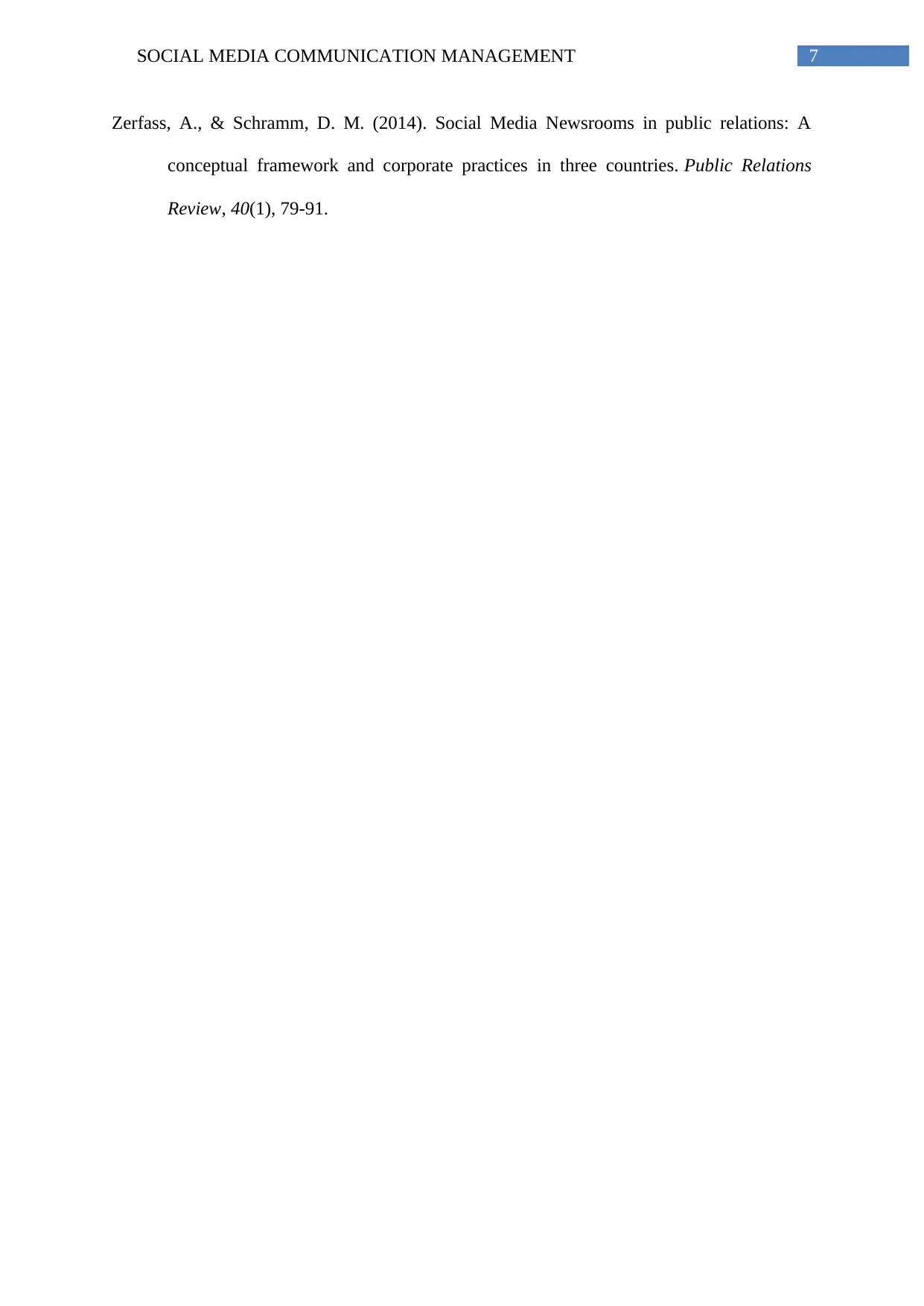
7SOCIAL MEDIA COMMUNICATION MANAGEMENT
Zerfass, A., & Schramm, D. M. (2014). Social Media Newsrooms in public relations: A
conceptual framework and corporate practices in three countries. Public Relations
Review, 40(1), 79-91.
Zerfass, A., & Schramm, D. M. (2014). Social Media Newsrooms in public relations: A
conceptual framework and corporate practices in three countries. Public Relations
Review, 40(1), 79-91.
1 out of 8
Related Documents
Your All-in-One AI-Powered Toolkit for Academic Success.
+13062052269
info@desklib.com
Available 24*7 on WhatsApp / Email
![[object Object]](/_next/static/media/star-bottom.7253800d.svg)
Unlock your academic potential
Copyright © 2020–2025 A2Z Services. All Rights Reserved. Developed and managed by ZUCOL.




